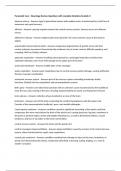Paramedic Care - Neurology Review Questions with complete Solutions Graded A+
absence seizure - Answers type of generalized seizure with sudden onset, characterized by a brief loss of
awareness and rapid recovery
afferent - Answers carrying impulses toward the central nervous system. Sensory nerves are afferent
nerves
Alzheimer's disease - Answers degenerative brain disorder; the most common cause of dementia in
elderly
amyotrophic lateral sclerosis (ALS) - Answers progressive degeneration of specific nerve cells that
control voluntary movement characterized by weakness, loss of motor control, difficulty speaking, and
cramping. AKA Lou Gehrig's disease
apneustic respiration - Answers breathing characterized by a prolonged inspiration unrelieved by
expiration attempts, seen in pts with damage to the upper part of the pons
arachnoid membrane - Answers middle layer of the meninges
ataxic respiration - Answers poor respirations due to central nervous system damage, causing ineffective
thoracic muscular coordination
autonomic nervous system - Answers part of the nervous system controlling involuntary bodily
functions. Divided into the sympathetic and parasympathetic systems
Bell's palsy - Answers one-sided facial paralysis with an unknown cause characterized by the inability to
close the eye, pain, tearing of the eyes, drooling, hypersensitivity to sound, and impairment of taste
brain abscess - Answers collection of pus localized in an area of the brain
brainstem - Answers part of the brain connecting the cerebral hemispheres with the spinal cord.
Consists of the mesencephalon (midbrain), pons, and medulla oblongate
Cauda equina syndrome - Answers condition caused by significant narrowing of the spinal canal that
compresses the nerve roots below the level of the spinal cord, causing back pain, leg pain, numbness in
the groin or perineal region, bowel and bladder disturbances, as well as diminished reflexes, muscle
weakness, and loss of sensation in the lower extremeities
central nervous system - Answers the brain and the spinal cord
central neurogenic hyperventilation - Answers hyperventilation caused by a lesion in the central nervous
system, often characterized by rapid, noisy respirations
central pain syndrome - Answers condition resulting from damage or injury to the bran, brainstem, or
spinal cord characterized by intense, steady pain described as burning, aching, tingling, or a "pins &
needle" sensation
, cerebellum - Answers portion of the brain located dorsally to the pons and medulla oblongata. Plays
important role in the fine motor movement, posture, equilibrium and muscle tone
cerebrospinal fluid - Answers watery, clear fluid that acts as a cushion, protecting the brain and spinal
cord from physical impact. Serves as an accessory circulatory system for the central nervous system
cerebrum - Answers largest part of the brain, consisting of 2 hemispheres. Is the seat of consciousness
and the center of the higher mental functions such as memory, learning, reasoning, judgment,
intelligence and emotions
Cheyne-Stokes respiration - Answers breathing pattern characterized by a period of apnea lasting 10-60
seconds, followed by gradually increasing depth and frequency of respirations
clonic phase - Answers phase of a seizure characterized by alternating contraction and relaxation of
muscles
coma - Answers state of unconsciousness from which the pt can't be aroused
complex partial seizure - Answers type of partial seizure usually originating in the temporal lobe
characterized by an aura & focal findings such as alterations in the mental status or mood
cranial nerves - Answers 12 pairs of nerves that extend from the lower surface of the brain
Creutzfeldt- Jakob disease - Answers rare form of brain damage that leads to a rapid decrease in mental
function and movement characterized by dementia, ataxia, hallucinations, jerking and general decline
Cushing's triad - Answers collective change in vitals signs (increase BP, decrease pulse rate, and irregular
respirations) associated with increasing intercranial pressure
decerebrate posturing - Answers sustained contraction of extensor muscles of the extremities resulting
from a lesion in the brainstem. Pt presents with stiff and extended extremities and retracted head
decorticate posturing - Answers characteristic posture associated with a lesion at or above the upper
brainstem. Pt presents with arms flexed, fists clenched, and legs extended
degenerative neurologic disorders - Answers collection of diseases hat selectively affect 1 or more
functional systems of the central nervous system
dermatomes - Answers areas of the skin innervated by spinal nerves
diencephalon - Answers portion of the brain lying beneath the cerebrum and above the brainstem.
Contains the thalamus, hypothalamus and limbis system
dura mater - Answers tough outermost layer of the meninges
dystonias - Answers group of disorders characterized by muscle contractions that cause twisting and
repetitive movements, abnormal postures, or freezing in the middle of an action




